- News
- Reviews
- Bikes
- Components
- Bar tape & grips
- Bottom brackets
- Brake & gear cables
- Brake & STI levers
- Brake pads & spares
- Brakes
- Cassettes & freewheels
- Chains
- Chainsets & chainrings
- Derailleurs - front
- Derailleurs - rear
- Forks
- Gear levers & shifters
- Groupsets
- Handlebars & extensions
- Headsets
- Hubs
- Inner tubes
- Pedals
- Quick releases & skewers
- Saddles
- Seatposts
- Stems
- Wheels
- Tyres
- Tubeless valves
- Accessories
- Accessories - misc
- Computer mounts
- Bags
- Bar ends
- Bike bags & cases
- Bottle cages
- Bottles
- Cameras
- Car racks
- Child seats
- Computers
- Glasses
- GPS units
- Helmets
- Lights - front
- Lights - rear
- Lights - sets
- Locks
- Mirrors
- Mudguards
- Racks
- Pumps & CO2 inflators
- Puncture kits
- Reflectives
- Smart watches
- Stands and racks
- Trailers
- Clothing
- Health, fitness and nutrition
- Tools and workshop
- Miscellaneous
- Buyers Guides
- Features
- Forum
- Recommends
- Podcast
feature
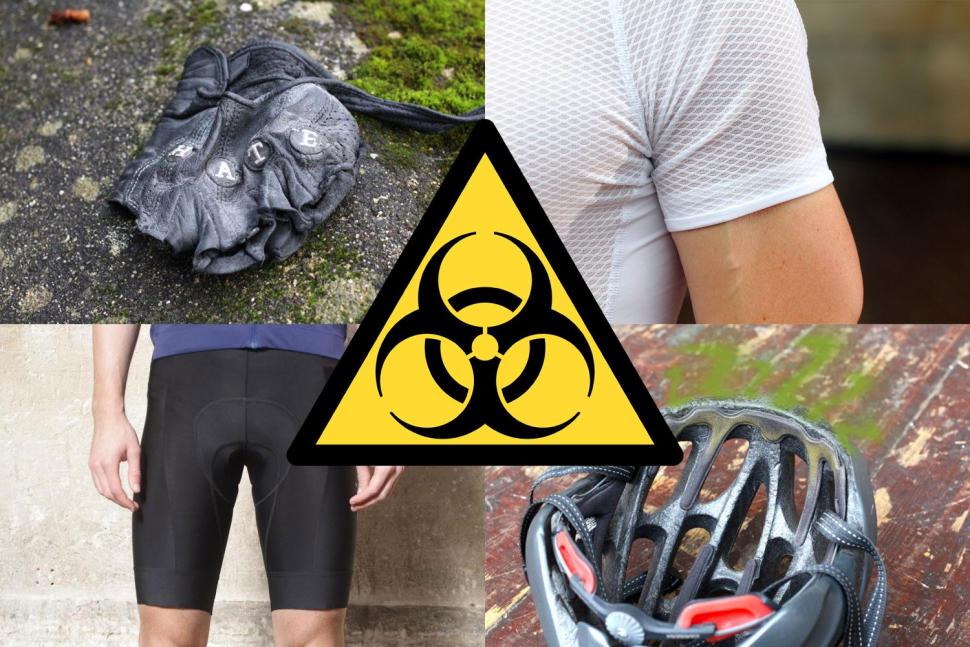 cycling-biohazards.jpg
cycling-biohazards.jpgCheck out the 6 worst bike kit bio-hazards — and how to beat them
Cycling: it’s healthy, it’s addictive, it’s an itch that every cyclist has to scratch. That’s just as well because all that pleasure can have a price, one that if you’re unlucky involves itching, scratching and a variety of noxious odours.
Most of us know about the smellier (and worse) side effects of cycling. Many of us simply accept them as part of the price we pay for our cycling addiction. But it doesn’t have to be that way. The bio-hazards we all face (well, ‘create’ if we’re being accurate) can be neutralised and beaten, you just need to know what they are, how to avoid them, and what to do if you can’t.
The following article lists the threats, the most effective avoidance techniques, and the remedies. It contains sweat, ointment, and cat litter. Oh, and it probably shouldn’t be read while you’re eating.
Helmet honk
We’re not going to rehearse all of the pros and cons of bicycle helmets here, but one undoubted downside for some people is that if you don’t keep it clean it will inevitably start to honk. Badly. We say ‘some people’ because in our experience helmet honk is the one cycling bio-hazard that doesn’t seem to affect every cyclist. Some people sweat buckets, never clean their lid and never seem to have a problem. Others only need to emit a mild glow for their helmet’s delicate ecological balance to be thrown out of whack with pongy consequences.
That’s not the worst of it either. A smelly, sweaty bike helmet can be a breeding ground for all sorts of nasties besides the bacteria producing the smell as they break down the secretions from your sweat. No, the worst of it is that various fungal spores also really like the tasty mixture of fats and sugars on offer in the warm, moist conditions of your cycle helmet, especially in summer. If they come into contact with your sweaty scalp they’ll have hit the mother lode and you’ll have an itchy rash on the top of your head. You might also get a rash or irritated skin on your forehead, under your chin or even down the side of your face from sweaty helmet straps.
Helmet honk and its attendant horrors are most likely to strike during the summer when it’s hot and you’re doing your best sweating, but it can strike any time if you sweat a lot and you don’t keep things clean.
What can be done?
Well, first off an ounce of prevention is worth a pound of cure, so regularly give your helmet pads, any lining, plus the straps a regular clean. How often? Well, give it a sniff and your nose will tell you. Your best bet is to wash the pads well in hot, soapy water, and sponge the straps an any soft material on the inside of the helmet in the same. You could also give the pads a splash of something antibacterial, although you should avoid letting anything solvent based come into contact with the helmet shell. You can get various helmet cleaning sprays and potions, but soap and water generally seem to do the trick.
Don’t worry if your helmet has given you a rash (it happens to the best of us). It’s most likely a sweat rash caused by the combo of heat, friction and close contact with the nasties in your helmet liner pads. Cleaning the pads should sort it. If it doesn’t, a quick visit to your pharmacist to get some antifungal cream should do the trick (we might as well just cut and paste that last line into the rest of the article now! – Ed).
Winter shoe
I’m getting a strong hint of expensive French cheese, probably artisan produced, whiffy but not in a totally bad way. That’s summer cycling shoes.
Now take your expensive cheese and spray it for three months in a mixture of black/brown road spray containing a nutritious mix of soot, salt, brake dust and, if you’re lucky enough to ride in the country, animal slurry. At the same time, marinade the inside (yeah, okay, the cheese analogy breaks down at this point) in sweat. Let it rest periodically to digest itself. That’s your winter shoe. It doesn’t just smell like a swamp, it IS a swamp.
The only good thing to say about the winter shoe is that it’s nowhere near as dangerous a bio-hazard to its owner or innocent members of the general public as its smell would suggest. If it were, you’d need a licence to own cycling footwear.
Ironically, it’s the cheesier summer cousin that’s a more conducive environment for athlete’s foot and the like, being generally warmer and sweatier. That’s not to say that winter cycling shoe can’t inflict some fungal damage to your feet, but depending on the amount of time you spend in the saddle and how hot and sweaty or cold and wet you get, it’s as likely to be trench foot as athlete’s foot that lurks in its dank, smelly interior.
No, the most usual and persistent hazard posed by the winter shoe is to your sense of smell, and also to your socks - just dipping your foot in them gives even the freshest pair of socks the taint of the swamp. Obviously, no one would be so stupid as to put their bare feet in there… would they?
What can be done?
You’re probably never going to get your winter shoes smelling as fresh as a new mown meadow, but there are some simple steps (no pun intended) you can take to greatly reduce their nasal impact.
1. Dry them properly after wet rides!
Don’t leave your shoes in a cold, wet post-ride heap decomposing by the door. If you do that they’ll warm up just enough for their microbial population to start multiplying, but not enough to dry out before you deliver another infusion of sweat and road spray.
Instead, put them somewhere warm where they can dry out properly. Stuffing them with old newspaper helps considerably. In extreme cases you can trying filling a pair of old socks with cat litter and pushing them right into your shoes. The cat litter should both absorb the moisture and neutralise the smell. This technique is a variation on something we’ve seen recommended for dealing with smelly gloves but it seems even more appropriate for cycling shoes.
2. Clean ’em!
No, not by going for a ride in a particularly heavy shower but by actually giving them a good wipe down, taking the insoles out and giving them a proper clean. You may even want to consider giving the insides a dose of antibacterial spray every now and again. Your shoes will thank you, and so will your nose… and the noses of anyone else who shares your home or workspace.
What about overshoes, over-socks and shoe covers?
Overshoes will keep some of the muck off but unless it’s properly cold it’s going to be sauna time for your toes. Also, depending on what they’re made from, even if they’re warm they may not actually keep the outside of your shoes dry for very long either. If you then take your shoes off with the over-shoes still in place you’ll just trap all that noxious moisture in there for even longer.
Over-socks? There is some debate in the road.cc office as to whether these are slightly pointless or totally pointless in wet conditions. They might keep your shoes cleaner than they’d otherwise be, but… pfft.
Don’t sniff the glove!
If someone ever worked out how to weaponise cyclist’s gloves we’d all be in deep do-do. Thankfully, that nightmare scenario hasn’t occurred yet, and nor has one entered the public water supply despite the predilection of sportive organisers up and down the land to play with fire by routing their events around reservoirs.
The glove is every cyclist’s guilty secret. We know what your gloves are like… and you should be ashamed of yourself.
Unlike the cycling shoe, your cycling glove generally (though not always) keeps its punch to itself. You have to get right up close and then… BAM! An olfactory overload that would fell a cart horse.
Summer mitts tend to be even worse than winter gloves. The combination of constant sweating plus regular nose-wiping (we did warn you that this wasn’t going to be pleasant) makes for a super-potent combo. Some nasty things live up your nose, and we don’t mean bogeys.
We’ve heard guilty tales of gloves that practically crackled when taken off. While your gloves are teeming with unpleasantness and in many cases are well on the way to becoming sentient life forms in their own right, we’ve not yet heard of anyone being harmed by them, although we’d never advise sniffing (even if you don’t inhale).
Finally, it’s probably worth saying that if you ever have to deal with a broken skin injury – your own or someone else’s – it might be an idea to take your gloves off first.
What can be done?
Easy! Wash your gloves regularly on the hottest wash they’ll stand – most care instructions say 30°C but I wash mine at 40°C – then dry them thoroughly.
Alternatively, another remedy we’ve seen touted is to cut the toes off old socks to create some small parcels that you fill with cat litter, then sew up and stuff in your gloves - the theory being that the cat litter both soaks up the moisture and neutralises the smells. Well, it works for cat pee. Anyway, we reckon that’s going a bit far.
Whatever you do, there may come a point where even washing your gloves isn’t going to make much of a dent in the smell. At that point you have two choices: learn to live with the smell or get some new gloves. We won’t judge you either way.
Crotch rot
Non cyclists always assume that a cyclist’s shorts will be the – what’s the technical term? – ah yes, ‘yuckiest’ bit of kit on the cyclist’s person, to which most cyclists will respond, “Pah! You haven’t sniffed my gloves.”
However, although the germ count and potential for mass slaughter residing in your gloves is not to be sniffed at (sorry!), it’s your shorts that have the ability to do you most harm.
Boils and irritating chafing are bad enough but ointments, better shorts, more regular changes, and generally keeping things clean will usually deal with those. Unfortunately, there is another hazard that is much, much worse. It goes by many names, crotch rot and jock itch being two of the most common. Basically, it’s athlete’s foot, but not on your feet.
All of the aforementioned remedies for boils and chafing will help guard against it, but they won’t necessarily be enough to stop you getting it. Once you’ve got it, crotch rot can be very difficult to get rid of.
How to keep things healthy in your shorts
Keep ’em clean. The combo of modern antimicrobial pads and detergents do a good job of dealing with the microbial load that builds up in your shorts during and after a ride, but don’t push it. There is much debate on how often you should change your shorts. Some say after every ride, regardless of duration, although these tend to be people who make shorts.
Many cyclists take a different view, reasoning that a week’s worth of short commutes might only add up, in sweat terms, to one weekend ride, so what’s the harm? That’s one you’ll need to work out for yourself. If you are taking this route, careful post-ride shorts monitoring is a must (there's a phrase you didn't expect to read today, right?). Obviously, if you start developing boils you’ve left things too long!
Get your shorts dry as quickly as possible once you’re out of them and give them a good airing. Turn them inside out.
Oh, and if you’re a commuter taking the multi-day approach to shorts hygiene and your workplace doesn’t have a shower, remember that the baby wipe is your friend (don’t flush ’em!).
Guarding against the fungal menace
First – and this is blindingly obvious – never, ever wear another cyclist’s shorts! Not even if they’re clean.
The microbiology and ecological balance of your shorts is unique to you. Some of the flora and fauna that have made their home there and which may well exist in benign balance with your nethers may turn rogue in combination with someone else’s ‘lower torso’ and vice versa, so just don’t do it.
For most cyclists the most likely cause of a fungal flameout in the shorts department is another bit of your own body, most likely your feet.
Athlete’s foot is more than happy to colonise other sweaty bits of your anatomy using your clothing as a method of transmission. For that reason, put on your socks before you put on your shorts to guard against fungal spores jumping off your feet and onto your seatpad on the way through.
You need to be just as careful if you ride in normal clothes rather than Lycra, particularly if you work up a sweat. We’d recommend having a change of underwear at work and adopting the same baby wipe routine as the Lycra wearer, otherwise you might as well buy shares in Canestan.
What to do if the itch strikes?
If you do get crotch rot, Canestan or another anti-fungal treatment is going to loom large in your life. If you’re lucky that will be enough, but while the antimicrobial pad in your shorts is great at fighting microbes, fungal spores are another matter entirely and once they are in there they probably ain’t coming out.
There’s more bad news: those fungal spores are also likely to be in any other cycling shorts you own and also in your underwear. A doctor I once asked about this advised a two pronged approach: regular applications of an antifungal cream plus getting rid of all your cycling shorts and all your underwear – yes, even those Power Ranger ones you got for Christmas in 1994 – and starting again. You can now see why athlete’s foot is so hard to get rid of. Not many of us want to chuck our shoes and socks away because we’ve got itchy feet.
Putrid base layers
Base layers have a difficult life shifting sweat away from your skin so that you stay dry and comfortable.
You have two different sorts of sweat glands. Eccrine sweat glands, which cover most of your body, produce water-heavy sweat that contains sodium, chlorine and potassium. Your apocrine sweat glands, located in areas where there are lots of hair follicles such as under your arms, produce a thicker mix that contains the regular ingredients plus fatty acids, urea and ammonia. Bacteria on the surface of your skin interacts with sweat, and it’s that which smells.
Your base layer has to cope with the lot, along with skin cells. It’s not a particularly pleasant soup and it gets worse the longer you leave it to simmer. Left unchecked it could be nasty.
What can be done?
The biggest problem for you and people around you is likely to be the odour. We all know that base layers can quickly start to reek.
Some base layers are more prone to smelling than others. We find that polyester base layers are often among the worst offenders. Wool, on the other hand, has natural antibacterial properties – those sheep are smarter than you might think – so it resists odours, and that’s one of the reasons many people love a merino next to their skin. Base layers containing bamboo (not sticks of the stuff, obviously) are designed to be antibacterial too.
The best advice is to wash your base layers frequently. You’ll probably want to wash synthetic base layers after every ride – certainly after every ride where you’ve worked up a sweat (and even if you ride at a low intensity, that’ll be the vast majority of them). If it walks to the washing machine on its own volition, that’s a sign.
You might get more than one ride between washes with wool, but you could check that your judgement is similar to that of other people by getting someone to perform a simple sniff test. It doesn’t matter what they say, it’s whether or not they flinch that counts.
Normal washing will kill most bacteria. If some bacteria do survive washing, it’s probably not a huge problem.
If your base layers still smell after washing – and some synthetics are far more prone to this than others – you can try something like Nikwax Basewash which is designed to clean and deodorise, and also to inhibit the build up of body odours in future.
It’s not a base layer but if you use a heart rate strap don’t forget to clean it regularly according to the manufacturer’s instructions. There are all sorts of nooks and crannies in those things where bacteria can hide away before jumping out on your skin. If you start getting unexplained spots or blemishes on your torso, your heart rate strap is a good place to start your investigations.
Manky water bottles
Water bottles can harbour all kinds of nasties if you’re not careful. Check the inside of your water bottle and chances are that it looks pretty clean, right? Now check the lid, and more specifically the valve. Still clean?
If so, you’re doing well. Often, though, residue from energy drinks and gunk from the road gets in there and it can be quite hard to get out, depending on the design… and then stuff starts to grow in there and you’re in all sorts of bother. Bear in mind that anything in your water bottle is going straight into your system in a very direct manner – not through your skin but straight down your throat.
A lot of big teams use water bottles once and then give them away. Washing them well enough to make sure riders stay perfectly healthy would take a lot of work, so the teams use their logoed up bottles as a marketing exercise and simply offload them.
For the rest of us who actually have to pay for our water bottles, that’s not a luxury we can afford.
What can be done?
You need to clean you water bottle carefully. You know that many (not all) bite valves can be removed for cleaning and replaced afterwards, right? You can just pull them away. If you’ve not done this before, you might be horrified at what you find lurking in there.
Clean your water bottle on the top shelf of the dishwasher (assuming the manufacturer doesn’t warn against this) or wash it by hand in warm, soapy water. A bottle brush will come in handy.
If you’re worried you can use something like Milton sterilising fluid to remove any micro-organisms from your water bottle, and sooner or later you’ll have to consign it to the bin and get a new one. We’re not advising you to lob away something just for the sake of it, but water bottles certainly have a shelf life.
road.cc'snder and first editor, nowadays to be found riding a spreadsheet. Tony's journey in cycling media started in 1997 as production editor and then deputy editor of Total Bike, acting editor of Total Mountain Bike and then seven years as editor of Cycling Plus. He launched his first cycling website - the Cycling Plus Forum at the turn of the century. In 2006 he left C+ to head up the launch team for Bike Radar which he edited until 2008, when he co-launched the multi-award winning road.cc - finally handing on the reins in 2021 to Jack Sexty. His favourite ride is his ‘commute’ - which he does most days inc weekends and he’s been cycle-commuting since 1994. His favourite bikes are titanium and have disc brakes, though he'd like to own a carbon bike one day.
Latest Comments
- LeadenSkies 6 hours 28 min ago
They are buses, not trains. They don't travel at 186mph or take over 2 miles to stop under braking. It should be inherently no more dangerous...
- don simon fbpe 7 hours 53 min ago
I'd go for 'the sun was in my eyes' as a defence, get away with murder with that one...
- PRSboy 9 hours 37 min ago
I have two aero bikes- an Argon18 Nitrogen and an Orro Venturi. I love the way they feel on the road. I also like the style of the deeper section...
- ridein 11 hours 34 min ago
I wonder if you could use a Northwave shoe (w/Speedplay drilling) on the Ekoi pedal. Possibly using one Look pattern cleat hole and two Speedplay...
- Rendel Harris 17 hours 14 min ago
They have here: results at 14.40. The aero bike was roughly fifteen seconds faster than a climbing bike on a descent of around 6 km, so about 3km/h...
- wtjs 17 hours 28 min ago
As I've also placed here the nutter Audi and white van drivers, I've decided to give those no-nonsense keep-the-country-moving BMW drivers a list...
- polainm 18 hours 31 min ago
100% this. Policing mentality is formed by social 'norms', and the cyclist witchhunting across social media is the UK norm. Close passing a person...
- David9694 19 hours 56 min ago
That's a clear 2 points awarded there, but I guess as there's now a 25% tariff you'll only get 1.5
- mark1a 20 hours 7 min ago
Fawkes Cycles is only local if you live near Oldham. That's nearly 300 miles away from me. Also, any retailer that doesn't participate in an...
- David9694 20 hours 9 min ago
Openreach under fire over delays to Amesbury cabinet repairs...



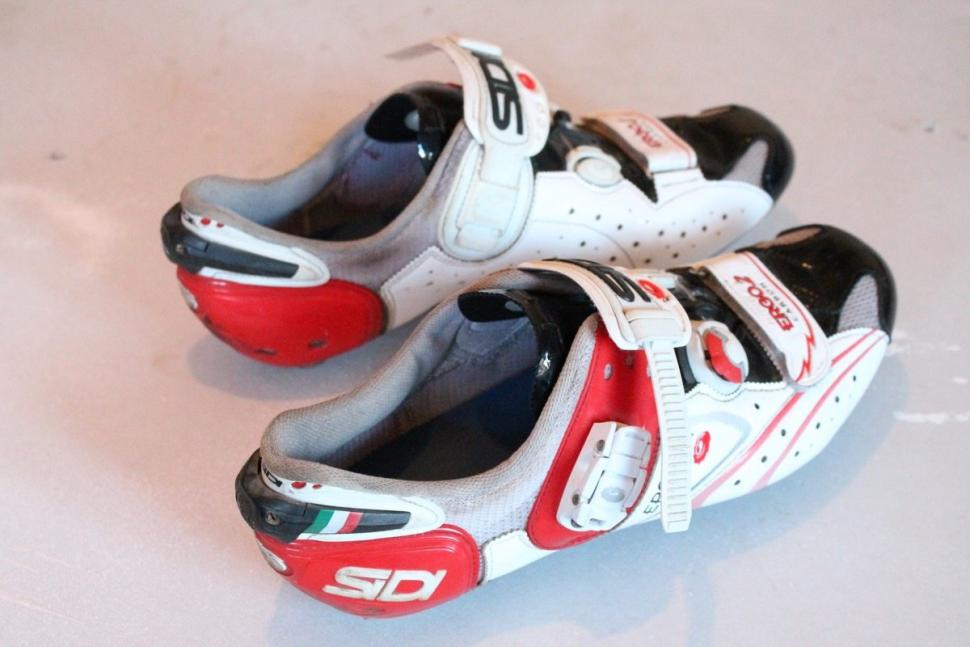
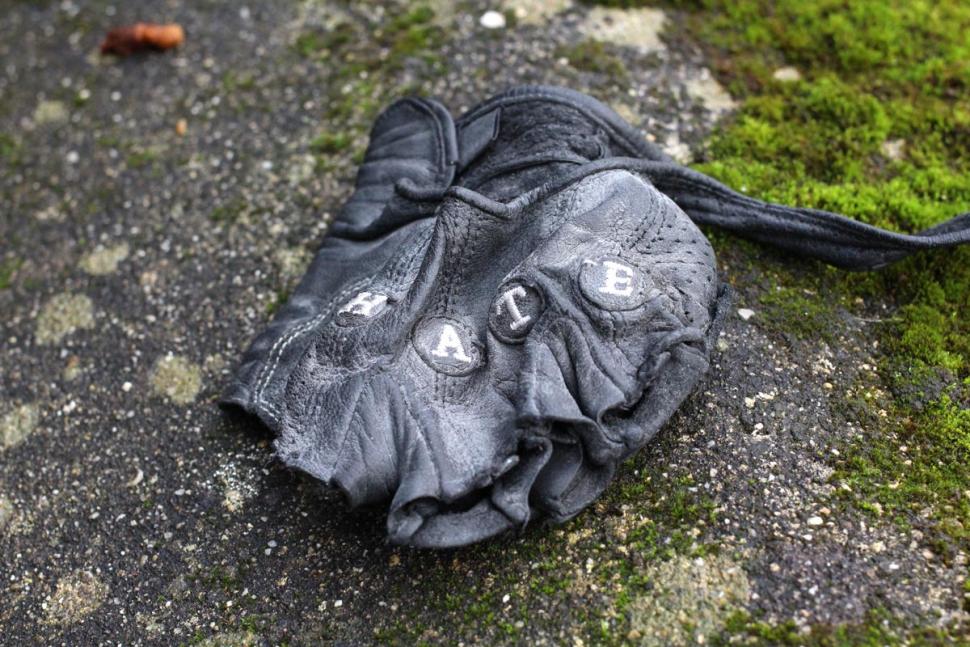


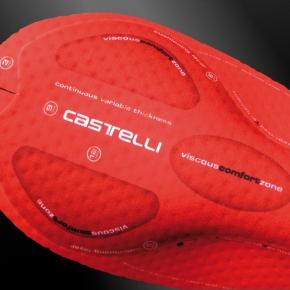

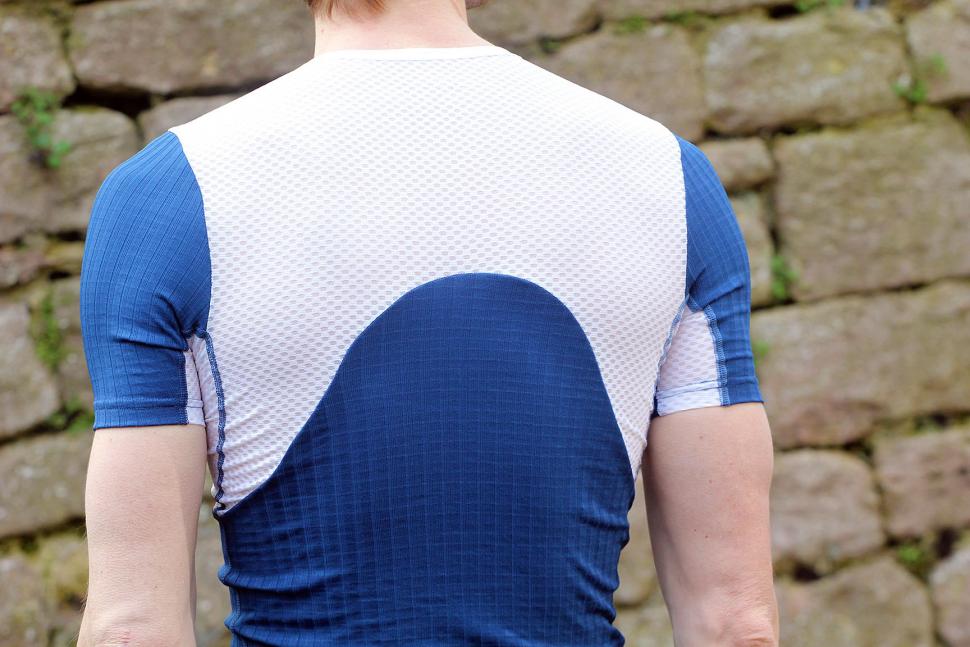


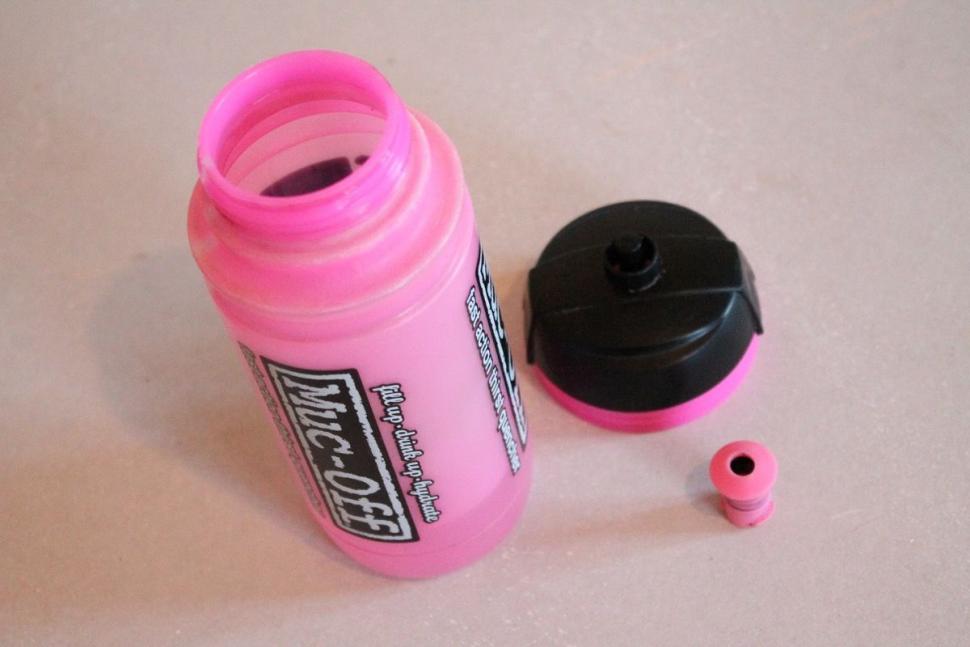
Add new comment
39 comments
I use denture cleaning tablets to clean bottles and my coffee Thermos. It gets them completely clean. I usually clean multiple at a time, so I mix it all up in one bottle with hot water, let it sit ten minutes, us a bottle brush then pour into the next bottle and top up if needed with more hot water. Repeat. Removeable valve parts get dropped in the bottle. Rinse well with hot water. Rinse any off your hands immediately.
Milton sterilisation tablets work for me. Soak the kit for an hour or more and then wash in the machine as normal.
My gloves I wear on the bike on the Zwift trainer get horrible after a few rides. Soaked in Milton for an hour and then washed – good as new.
Original Listerine is a mixture of plant essential oils that is very effective at dirupting biofilms and could help with these problems. Diluted somewhat, might be good for pre wash soak of bike shorts. I think it's possible for contaminated shorts to cause urinary tract infections, even in men.
A small amount of apple cider vinegar judiciously applied to crotch rot problem areas helps to maintain normal skin acidity which inhibits growth of bugs that cause cheesy, stinky buildup.
Specialized has water bottles with a silicon based inner coating. Easier to clean, and chemically inert. No plastic taste.. that stuff cannot be good for you.
Helmets and non leather shoes are not harmed by water... so why not wash them whole in a pail of water with laundry detergent. Open up the tongues of the shoes and aim a small fan at them, to dry out the insides in no time.
Cheap solution to honking washable kit - put 1 cup of white vinegar in the detergent drawer of your washing machine along with your usual dose of detergent.
Your kit will come out stink-free & the stink won't reappear as soon as your kit starts to dry.
Bag your shoes and stick them in the freezer for 48 hours to kill the bacteria that cause smells.
Freezers don't kill bacteria, they just slow them down for a while.
15 minute quick wash at least every other day for commuting kit, and a full wash periodically. Anything that has a whiff about it goes in the wash straightaway, before it dries.
Shoes get 'Boot Bananas' after every ride (bicarb-filled shoe thingies) and live on top of the boiler. They do still smell a bit - a nasty cross between singin nettles and pee, but it's getting better with the use of boot bananas. Insoles go in the wash with the other stuff.
Gloves get a very thorough hand wash periodically
No mention of bar tape. I read somewhere that you should replace bar tape annually, because of the build up of nasties.
Which was news to me, as I've only ever bothered when it's been damaged or I've needed to replace shifters/cables - the rest of the time, it gets a good wash with the rest of the bike.
I crash more than once a year, which usually takes care of that one!
I live in the tropics, so crotch rot is a constant issue. After years of struggles with it, I discovered that Bepanthin (baby ointment) is by far the most effective treatment, and much less expensive than things like Canestin. Get it from the baby supplies area in the supermarket. It also works well applied sparingly between the toes if you have some athlete's foot. It also comes in large tubes, so if pressed you can coat your chamois in it before a long ride. Recommended.
1h / 60 deg wash. All problems solved and no effect on a fabric.
Your should limit the use of anti-biological chemicals, because they will become useless as the microorganisms adapt (this is already a serious problem) and may not soak in enough or wash out easily; it's better to use cleaning/release chemicals like detergents, soaps, vinegar, baking soda, salt and Xylitol, with warm/hot water.
Febrese is not a deoderising product, like most 'air freshers' it is a nasty VOC chemical which masks smells by poisoning nose smell cells; My multi-stage air cleaner indicates Red (worst air quality) and sped up when I rarely pump spray Febrese several metres away!
Most wearable stuff is best cleaned in a washing machine, even my back pack goes on a synthetics wash when it get pongy, sometimes with specialist waterproof compatible detergent and waterproofing liquid.
Anything that may be delicate, like removable helmet liner/pad, gloves, thin clothing should go in a fine weave delicates washing machine bag (the larger ones may be called Bra washing bags) to prevent loss or damage. Any microfibre fabric must not be washed with fabric conditioner, because it clogs it!
Cleaned Shoes can be fully dried in a heated, vertical tent drier, suspended from one of the hanger supports or with an insertable warm air shoe drier; trying to do this with a radiator, boiler or tumble drier may leave tide lines, damage the shoes , take longer or only partially dry the shoes.
Hard surface stuff (e.g. for crud on shoe soles, electronics, and bicycle pedals, wheels and gears) can be cleaned faster with battery powered, wheel cleaning brushes, like ALDI/LIDL sell on occasion.
Wash yourself and clothes and you and they wont smell. Simple and effective
There is a product called trigene. Its often sold as 'safety wash' - we use it to clean breathing apparatus masks. It is absolutely astonishing for this problem. Make up a warm dilute solution in a bucket then chuck everything in. Kills all bacteria and removes all dirt.
Cleansing fire!
During transcontinental racing i wore my kit for 10 days straight, with owt but wearing it in a stream or shower to clean it.
suffice to say, it never got clean even upon returning home.
Rather wonder if the issue with shoes is the materials used - I get smelly feet in synthetic trainers, but my Lorica sidis are prett whiff-free..
An easy solution for "helmet honk" is the trusty old casquette, or cycling cap. Well fitting and made with the appropriate materials, it can even be worn when the temperatures are well into the double digits.
Halo Sports Wash...... Anti Bacterial, Anti Fungal and no softeners ( which will extend the life of your kit )
Seriously its the wonderstuff... Find an old honking hansen base layer, and a couple of washes later it will be as fresh as new....
http://www.halononbio.co.uk/halo-sports/halo-proactive-sports-wash-1ltr
Sold in many branches of Sainsbury's - if your local branch doesn't, keep asking at the customer service desk and they soon will
I'm a Halo convert of many years; nothing else comes close. We also use it for "normal" sweaty stuff like smelly school shirts and blouses - and it even deals with abused and abandoned trainers. It de-whiffs EVERYTHING. Halo also make a preventative antibacterial / antifungal shoe spray, which works well. But don't pay more than you need to! Look no further than CRC:-
http://www.chainreactioncycles.com/halo-proactive-sports-wash-laundry-li...
The only word of warning is that you apparently shouldn't use Halo if you have a septic tank - the enzymes could cause problems. I almost want to see what would happen, like the fascination of a "Baking soda and vinegar" Chemistry lesson, back in the day....
Thanks for that rothbags. I popped into Sainsbury's in Wigan but they didn't stock it so I just ordered a couple of bottles from Wiggle. I've had a dose of jock itch recently and this should definitely help keep my bibs hygienic!
As a cycling commuter during the week, club runs over the weekend I use Dettol antibacterial soap all the time to wash with in the shower, helps keeps clean and crotch rot at bay!
I've put helmet straps and pads through the washing machine before when they were especially sweaty, but, depending on the helmet design, they can be a bitch to get out and then you have to get them back in and adjust them all again.
Can vouch for Canestan for crotch rot - only seem to get it if I don't shower immediately after a ride/run, though.
Never had a problem with bottles, but always make sure they get washed after a ride.
I've used some of the sports wash/gym kit detergents that are in a lot of supermarkets, they seem to do the trick on most things, especially if the washing machine isn't packed (give the thing a chance to do it's job).
Haven't tried white vinegar yet but I'll definitely give it a go, it gets used for all sorts of cleaning jobs in the house.
Letting kit air dry before it goes into the linen bin also seems to make a difference, stops it from festering away for a day or two before it gets cleaned.
I use baby wipes to clean my helmet (and bike when I feel lazy). Denture tablets to clean my water bottles if or when they are stale. Like arno above I use Napisan for all my cycling kit in the washing machine, my local Tesco and Waitrose both stock it but it is in the baby section rather than the laundry section. For my backpack straps and pads I spray them with anti bacterial kitchen spray whenever they are sweaty.
Bloody hell. Cycling seems a bit like this..
Luckily for me I fall into the dirty but still somehow not turned in a fungus man category. I don't sweat much and it's rare day I ever pong so I've never given much thought to any of this as I've not suffered any of these ailments.
WHITE VINEGAR, PEOPLE! WHITE VINEGAR!!!
SHOES: Keep your shoes on top of the boiler when not in use. If they get really, really cat-piss whiffy, wash then then rinse in a strong bicarb of soda solution. You'll have white tide marks on your shoes, but they'll be fresh as a daisy.
FOR EVERYTHING ELSE: there's white vinegar. Spray generously on the crotch/chamois, underarm, socks (if needed), gloves, snoods (notice more spots in winter?), headband and everywhere there's lots of sweat. Leave for about half an hour. Then wash your stuff as normal. You can chuck extra vinegar into the wash especially if you're in a hard water area as it'll make the washing powder work better too. And it works on technical gear as well as natural fabrics.
It's also cheap as chips off Amazon, especially if you buy in bulk and decant it into a spray bottle you already have. Buy this double-strength stuff and give club members bottles as belated Christmas presents:
http://amzn.to/2hWpShW
Or just go for the I'll-clean-the-whole-house-with-it option, as it's excellent at shifting limescale too:
http://amzn.to/2hYh89q
Btw, anti-perspirants also can fuck up your clothes. All those ingredients that are supposed to keep it on your skin? They make it harder to remove from your clothes, and lock the stench into the fabric. If you're going to be sweating anyway, you may as well change to a deodorant like this - better for skin and fabrics and lasts for years:
http://amzn.to/2iWbbIO
'cos sweat only smells bad when it's stale. And fabrics such as merino, (if washed well and not coated in anti-perspirant) shouldn't stink at all.
But seriously, save your clothes and your pocket and the environment, etc. White vinegar.
You can get a 5L bottle for £3 at your local greengrocer (sold for pickeling). We've been using it as a universal organic cleaner/descaler for decades.
My water bottle gets a clean every night when I make a cuppa. A bit of hot water in the bottom from the kettle, put the lid on and squueze out through the nozzle then a proper clean at the end of the week doing the same but with washing up liquid and thoroughly rinsing through, nobody wants to taste washing up liquid out on the ride. Gloves get washed twice a month and all other cycling clothing gets worn for one day then chucked in the washing machine when I get home.
Pages